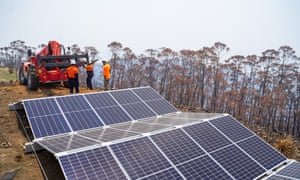Exclusive: Government urged to make clean energy part of Covid-19 recovery, as RBA finds 50% slump in projects last year
Adam Morton Environment editor
Adam Morton Environment editor
New research by the Reserve Bank showing renewable energy investment
fell sharply last year is fuelling calls for federal and state
governments to back changes to help the industry rebound and drive a post-pandemic recovery.
Renewable energy surged to make up nearly 5% of non-mining business investment across Australia in 2018, according to the research note by RBA economists, but the number of large-scale clean projects reaching the point of commencement slumped about 50% last year.
Investment is expected to fall further over the next year or two, in
part due to the national renewable energy target being filled and not
replaced and challenges in integrating solar and wind farms in remote
parts of the national grid.Renewable energy surged to make up nearly 5% of non-mining business investment across Australia in 2018, according to the research note by RBA economists, but the number of large-scale clean projects reaching the point of commencement slumped about 50% last year.
The Morrison government has defended criticism of its response to the climate crisis in part by saying record levels of wind and solar power were added to the grid last year as investment in 2018 flowed through. It is yet to acknowledge the subsequent fall.
“There’s no doubt this is more than a nudge and wink. It is saying this is where we should be going,” he said. “With Covid, it’s even more important. It is an opportunity to take a long-term strategic view in the national interest and looking ahead to where the country should be going given its [solar and wind] assets.”
The RBA note was quietly published online on 19 March, before the impact of the Covid-19 imposed economic shutdown. It comes to light during a growing push internationally and in Australia for policymakers to use stimulus programs designed to help the economic recovery to also address the climate crisis.
Hewson said the renewable energy industry did not require subsidies, but needed improved regulations and a clear policy framework that made clear fossil fuels would be phased out and the country would move to low greenhouse gas emissions over the next three decades. With renewable energy cheaper than its fossil fuel competitors, he said the grid could run on 100% renewable energy well before 2050 with the right support.
Erwin Jackson, policy director with the Investor Group on Climate Change, said the RBA note showed renewable investment had been an important contributor to economic growth but had fallen, in part due to policy paralysis.
“The critical implication of the analysis is that the industry faces the risk of a boom-bust cycle,” he said. “Governments can help stimulate new investment, and in turn new jobs and growth, by prioritising a net zero emissions transition and clean energy plans in a sustainable recovery from Covid-19.”
The RBA research echoes assessments by industry group the Clean Energy Council and consultants Bloomberg New Energy Finance, which both found investment in renewable energy projects was cut in half last year.
Alan Rai, a former senior economist at the RBA, now a director with consultancy Baringa Partners, said the central bank’s focus on the scale and benefits of renewable energy spending was instructive. The bank had been concerned about the level of non-mining investment since the global financial crisis in 2008, he said.
“The fact that renewables have become such a big pipeline of non-mining investment and then fallen drew their attention,” he said. “It is important to the country on a macroeconomic level.”
The report found the longer-term outlook for clean energy investment was more positive, but would depend on government policy, electricity grid considerations and wholesale electricity prices holding up. Prices have fallen in recent months and are expected to stay low if the economic impact of the shutdown is extended.
Prof Frank Jotzo, director of ANU’s Centre for Climate and Energy Policy, said the renewable energy boom has helped bring down electricity prices in the wholesale market and cut emissions. Electricity sector emissions were 7% lower in the first quarter than at the same in 2019.
But he said lower electricity prices meant lower revenue for renewable plants, and there were no longer sizeable subsidies. “If the Covid economic trouble turns into a prolonged recession, this could also pull the rug from under planned wind and solar power investments,” he said.
“That means a risk that there may not be sufficient renewable power available to easily cover for the next coal plant shutting down. It also means that we would see an end to big annual emissions reductions from the power sector, making it harder to achieve the 2030 emissions target.”
Jotzo said federal and state governments should step into the breach and contract for the construction of wind and solar parks in identified renewable energy zones.
“Public investments or financial guarantees for developments in the renewable energy zones are a safe bet, because we know that these investments will be needed, and they will be an excellent way to stimulate the economy, especially in the regions.”

No comments:
Post a Comment